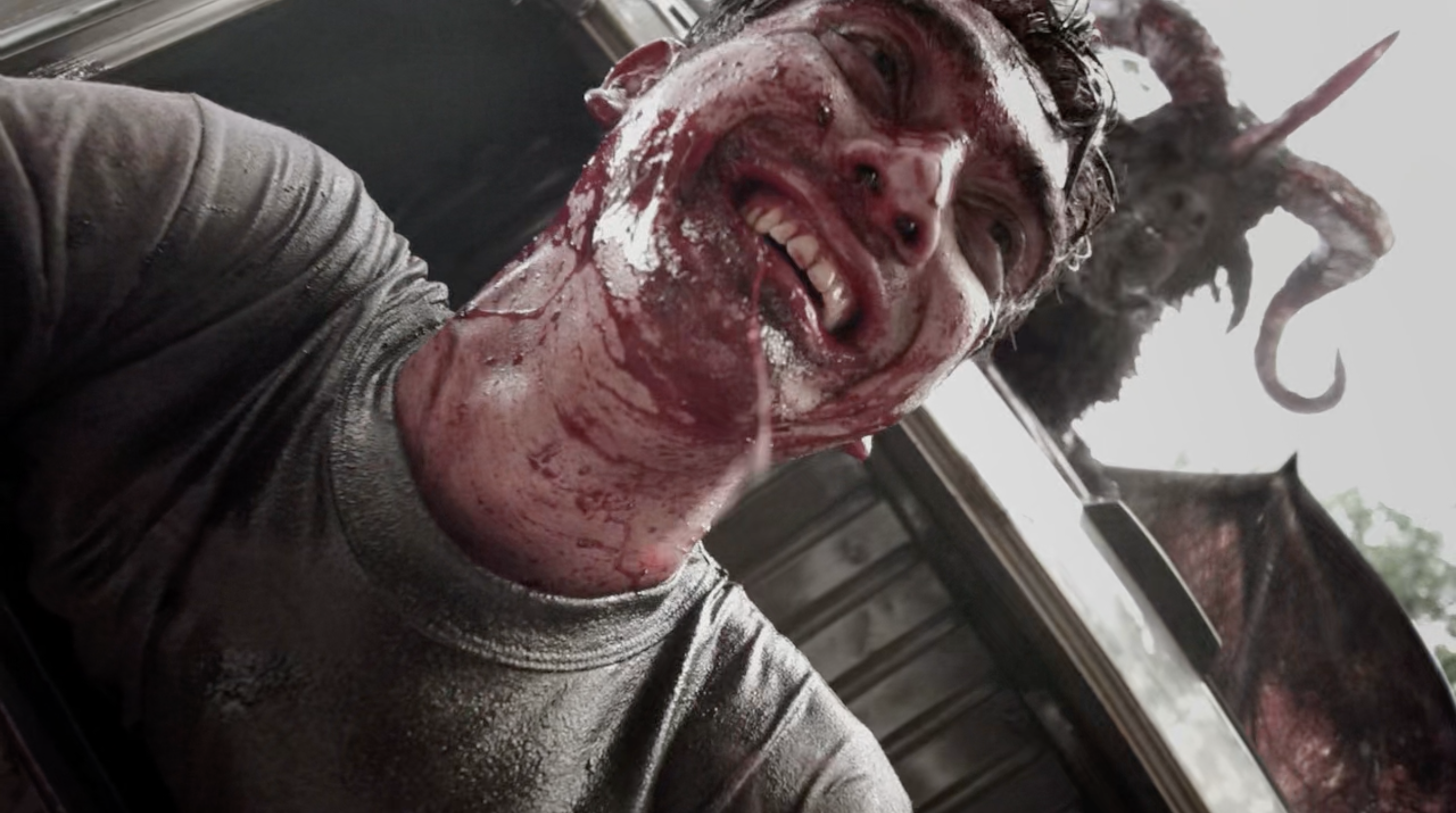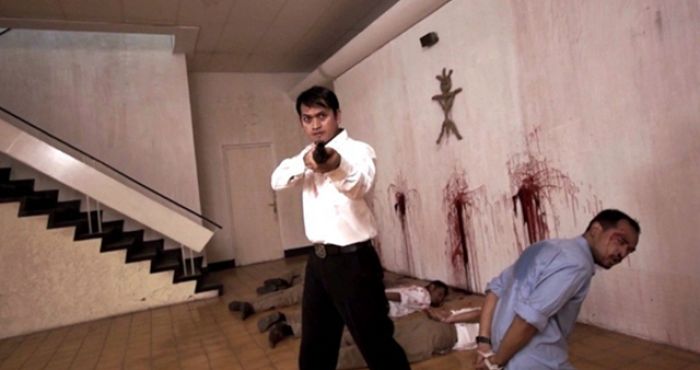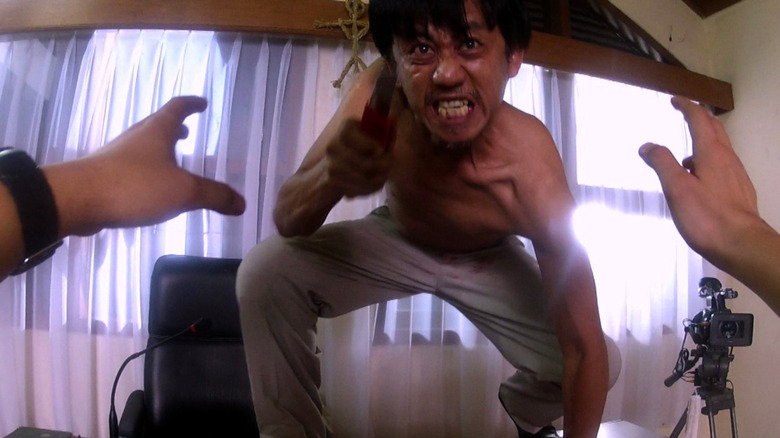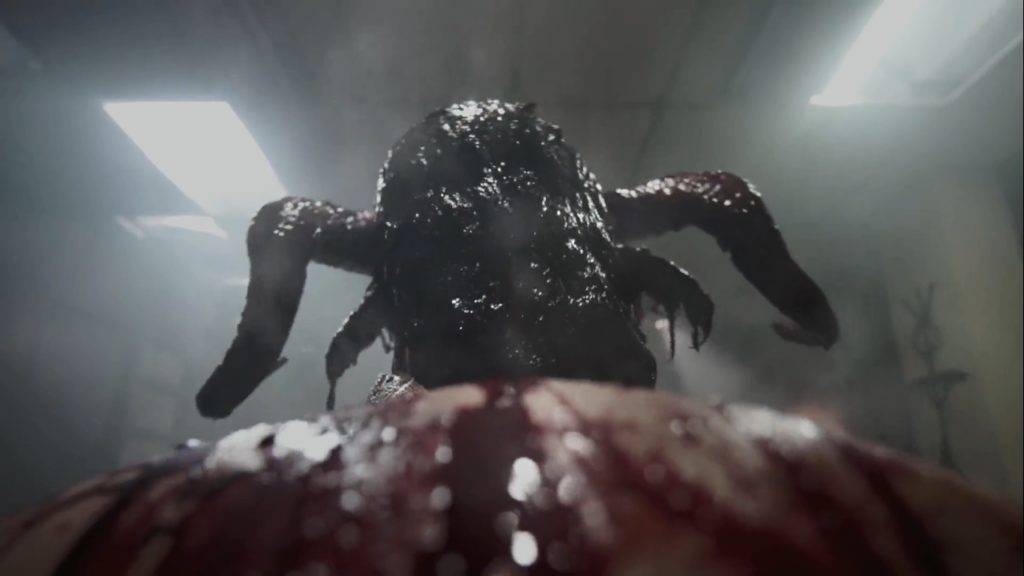Video killed the morning star
(FULL SPOILERS FOLLOW)
Maybe this is me showing my age, but it doesn’t feel like so long ago that found-footage was the new hotness in horror movies. The style that was inaugurated by Cannibal Holocaust and codified by The Blair Witch Project became the mainstream norm for a while in the late 2000s and early 2010s, in the wake of Cloverfield and Paranormal Activity. There are all sorts of reasons the subgenre might have flourished for a few years – the widespread proliferation of consumer recording equipment, of newsworthy events being captured by civilian passers-by, and the newfound ease of file-sharing in the broadband era, all created a new aesthetic of “authenticity,” wherein the legitimacy of an image could be certified by the camera-operator’s ill-preparedness to capture it. Horror all got a bit Marshall McLuhan for a while; the reality of a zombie felt just that bit more persuasive when it was something you glimpsed at the corner of the frame, out of focus and rendered indistinct by motion blur because the person holding the camera is running away. Hell, even George Romero himself tried it out.
It was a gimmick perhaps destined to be consigned to a narrow stratum of history – you can only see professional movies acting like footage recovered from the bodies of massacred teenagers so many times before the sheen comes off the verisimilitude, and there are a limited number of stories the format is suited to tell. Still, for a while there, it was a style that fired the imagination, that made you consider the possibilities for how stock horror scenarios could be recontextualised by making the camera an involved, diegetic participant. It made you want to see different interpretations of the concept; of how it might be twisted and stretched and riffed on by a variety of creative minds. It was, in short, kind of the perfect basis for an anthology movie.
It’s maybe not a surprise, then, that V/H/S – a franchise created by producer Brad Miska, the founder of the website Bloody Disgusting – has had such a long shelf-life. The first instalment came out in 2012; the most recent, V/H/S/94, came out in October 2021 (on Shudder, of course), with no indication that the series is stopping. They make for a kind of social-media age equivalent of swapping scary stories around the campfire, each teller trying to one-up the last, a cinematic equivalent of Creepypasta for the mumblecore crowd. They’ve had segments contributed over the years from figures like Joe Swanberg, Ti West, Adam Wingard and Simon Barrett, the reigning luminaries of indie horror in the early 2010s, before A24, Robert Eggers, Ari Aster and “elevated horror” came along to displace them.
…a kind of social-media age equivalent of swapping scary stories around the campfire, each teller trying to one-up the last, a cinematic equivalent of Creepypasta for the mumblecore crowd

Gareth Evans and Timo Tjahjanto were approached separately from one another by Bloody Disgusting in 2012, soliciting their contributions for the hastily assembled follow-up to the original V/H/S. Despite being based in Indonesia, geographically far from the US-centric production, it’s easy to see why they would have been seen as a good fit for the IP – both young, hungry gorehounds in their early 30s, both with a proven track record of assembling violent, independent genre movies. The two filmmakers had been associates and friends for several years at that point, since Evans had arrived in Indonesia – during his stint living and working in the country, he and Tjahjanto would routinely poach cast members from one another – and they had kicked around the idea of collaborating for a while. When Miska’s people came knocking, it was a serendipitous opportunity to make it happen. They put their heads together and came up with Safe Haven, a short made from the perspective of a documentary crew given access to the compound of a Jonestown/Heaven’s Gate-style cult, whose leader’s doomsday prophecies turn out to have some real substance to them.
The project gives the definite impression of having been a bit of a lark for both its co-directors, a minor work allowing them to blow off some steam in between their ambitious feature-length action epics. But if it I’m right, and Safe Haven was simply a low-stakes experiment for its creators, then damn, was it a successful one. A quick canvas of reviews of V/H/S/2, both from critics in 2013 and on Letterboxd today, will turn up an overwhelming consensus: Safe Haven is so good that it puts the anthology’s other segments to shame. It’s probably not a stretch to say that Evans and Tjahjanto’s contribution is single-handedly responsible for V/H/S/2’s Fresh score on Rotten Tomatoes.
It’s probably not a stretch to say that Evans and Tjahjanto’s contribution is single-handedly responsible for V/H/S/2’s Fresh score on Rotten Tomatoes.
I am 100% on board with the consensus in this regard, though I do note, with a degree of irony, that of the five segments that make up V/H/S/2, Safe Haven is by far the least invested in the concept of “found-footage.” Ever since Ruggero Deodato was taken to court after Cannibal Holocaust and had to prove he hadn’t actually murdered his actors IRL, the, shall we say, kayfabe of found-footage has receded. The ARG element, whereby the recovery and assembly of the footage is itself a part of the film’s fiction, was progressively left by the wayside as the genre matured. Safe Haven barely even musters the effort to pretend; by Evans’ own, up-front, enthusiastic admission, it cheats like hell. The film writes for itself a set of circumstances within its own diegesis that it’s saturated by camera coverage; not only do the documentary crew arrive at the cult compound with a plethora of cameras, both shoulder-mounted broadcast models and body-mounted button-cams, but the compound itself is just lousy with CCTV. Who went in after the apocalyptic massacre that ensues, to gather together the footage from both the cult’s servers and from the slaughtered documentarians? Who pieced it together into a chronologically coherent narrative, complete with elaborate cross-cutting? How did the finished result end up on one of the video cassettes being viewed by Larry and Ayesha in the Tape 49 wraparound segment? For that matter, most of the spoken dialogue is in Indonesian – are we to understand that Ayesha speaks Indonesian, or are the subtitles diegetic? And if they are diegetic (they certainly don’t look burned-in on the version I watched), then who did the laborious job of subtitling these illicit, occult snuff tapes?

Safe Haven’s answer to all these questions is a resounding “who gives a shit???”
Obviously, I don’t know exactly what the division of labour was between Evans and Tjahjanto on-set. Evans was the name that the English-language press latched onto when the film was released (the cynic in me supposes that this was because he was white, and had an easy-to-pronounce surname). It’s worth noting, though, that although The Raid drew on some of the visual grammar of horror films, Tjahjanto was the one who had experience making a full-throated, no-two-ways-about-it horror movie (2009’s Macabre). He was the one who had experience working with Epy Kusnandar in a segment of a horror anthology (they’d previously contributed L is for Libido to 2012’s The ABCs of Death). He was the one to suggest the short’s premise, and he’s assigned “story by” in the end credits. And, tellingly, he was the one who would later come back to contribute another segment to the V/H/S franchise (namely, The Subject, for last year’s V/H/S/94). Altogether, Safe Haven probably springs less from Evans’ imagination than it does from Tjahjanto’s.
But, on the other hand, Evans is credited as Safe Haven’s sole editor, which goes a long way to explaining the final shape the short took. If Tjahjanto was more the ideas guy, Evans was more the one responsible for the tweaks and the nip-tucks, for massaging the raw material into a finished product. As mentioned in part 3, Evans is someone who distrusts gimmicks. He’s not against stylisation; far from it. But he’s definitely opposed to any technique that places a membrane between his audience and a scene’s visceral, emotional content. Hence, Safe Haven: a piece of media that feels at odds with itself in a way. It holds itself to the strict aesthetic requirements of found-footage horror, but it devises all manner of loopholes and escape-clauses for itself, gives itself license to act more like a film with conventional continuity editing.
…it devises all manner of loopholes and escape-clauses for itself, gives itself license to act more like a film with conventional continuity editing.
And I’m perfectly fine with that. The moral of the story is, styles and formats and aesthetic schemas come and go, but there’s really no substitute for rock-solid, nuts-and-bolts filmmaking technique when it comes to establishing tone, creating atmosphere, and building tension. Compare Safe Haven to the segments preceding it; Adam Wingard’s Phase I Clinical Trials, filmed from the perspective of the protagonist’s newly implanted prosthetic eye, through which he starts to see ghosts, and Eduardo Sanchez & Gregg Hale’s A Ride in the Park, shot from the perspective of a cyclist’s helmet-mounted Go-Pro while he’s bitten by, and transformed into, a zombie. Those are both pretty neat conceptual hooks, but in the execution, neither does much to consolidate their original good idea, or use them to create specific scenes that grab you.
(Although, to be perfectly fair and balanced, the former more than the latter; I actually think A Ride in the Park is pretty OK, and easily the second-best entry in the anthology, but still more memorable for its gimmick than for anything it does with it. Also to be fair and balanced, the final segment, Jason Eisener’s Slumber Party Alien Abduction, isn’t really built around a gimmick either, unless “is puerile and terrible” counts as a gimmick.)

If Phase I Clinical Trials and A Ride in the Park possess what we might term “top-down” creativity, Safe Haven, by contrast, possesses “bottom-up” creativity; no perspectival USP, no groundbreaking conceptual hook; just a ton of little choices, bits of specificity and detail, individually memorable images and beats meted out across its half-hour runtime with impeccable timing and craftsmanship. The build-up in the first half, as the documentary crew are introduced to the cult and given a tour of their compound ahead of their interview with its leader, is fabulously economical in how it accumulates layer after layer of unease. It starts with Epy Kusnandar’s fabulous performance as “Father,” who nails the vibe of a sleazy, sociopathic cult leader talking to journalists; he’s effusive and confident, while at the same time being bristly and defensive and high-strung, and it’s not quite clear, until it’s too late, how genuine he is in his beliefs, or how much he buys into his own hype.
Then there are the little touches threaded throughout the crew’s arrival at the compound. There’s the brief exchange with the young girl, who politely introduces herself, and then innocently says something that hints she might have been sexually abused by “Father,” using vague euphemisms that suggest she’s thoughtlessly repeating the dogma she’s been taught. There’s the thread of dry humour in the way the camera operators are awkward around “Father,” embarrassed by technical hiccups and wilting under his silent, unsympathetic gaze, introducing an element of levity while reinforcing the cult-leader’s creepiness simultaneously. There’s the way the cult seems to be aware of Lena’s (Hannah Al Rashid) early-term pregnancy, despite her efforts to keep it a secret from her cuckolded fiancée Malik (Oka Antara).
And then in the back half, all hell breaks loose, in both the figurative and the literal sense. I admit, after having seen Safe Haven several times now, my understanding of its events is still pretty unclear. I don’t really know what the deal is with the demonic forces acting upon and through the cult, or why they chose this moment in particular to break the seventh seal. I don’t know why some cult members try to escape, or why other cult members gun them down; why some commit suicide, and others are possessed. I don’t know why one particular man straight-up explodes into bloody gibs. It’s a good thing I don’t care; here’s one place where the found-footage format offers an advantage. An imperfect, inconclusive comprehension of the situation is part of the fiction; it’s not just forgivable, it’s desirable.

Far more than being a coherent story of the occult, Safe Haven is interested in being a rollercoaster; an adults-only spookhouse carnival attraction. It’s an exceptionally gory movie, with a bunch of close-up shots of throats being slit with stanley-knives, or faces being blown off with point-blank shotgun blasts. The big centrepiece sequence, the demonic birth, sees poor Hannah Al-Rashid go through an act of violation so extreme it would raise eyebrows in a New French Extremity film – about the closest thing I’ve ever seen to a Cannibal Corpse album cover realised in a live-action movie. It speaks to Tjahjanto’s and Evans’ command of tone that all of Safe Haven’s grue reads as playful and exhilarating, rather than sordid and harrowing. The camera pauses for each of the escalating atrocities presented to it, but never lingers; it’s always darting, hurrying, rushing to arrive at the next one. Safe Haven does a bang-up job getting us into the adrenalised headspace of someone fleeing from threat to threat. Though it might nominally occupy a different genre, it’s not hard to see how you get here from The Raid (indeed, parts of Safe Haven were filmed in the same dilapidated building).
..about the closest thing I’ve ever seen to a Cannibal Corpse album cover realised in a live-action movie.
I’m not a huge fan of the demon that pursues Adam (Fachry Albar) during his escape from the compound in the last few minutes. The resemblance to Lévi’s Baphomet is a bit hokey, and its single, spoken word in the segment’s very last moment (which was apparently a “fuck it; why not?” instance of on-set improvisation) tips the whole affair more toward camp than I would prefer. But it’s not by any means a deal-breaker; Safe Haven is such a headlong rush of horror imagery, such an effective thrill-ride through a fecund, macabre imagination, that I can forgive it some cheese.
More than anything else, it served to whet the appetite. After The Raid Gareth Evans was a star; an internationally known quantity. Safe Haven was what we got when he was given license to indulge himself on a small scale. What would happen if he indulged himself on a grand scale?
- Review Series: Gareth Evans
Is It Good?
Very Good (6/8)
Andrew is a 2012 graduate of the University of Dundee, with an MA in English and Politics. He spent a lot of time at Uni watching decadently nerdy movies with his pals, and decided that would be his identity moving forward. He awards an extra point on The Goods ranking scale to any film featuring robots or martial arts. He also dabbles in writing fiction, which is assuredly lousy with robots and martial arts.

